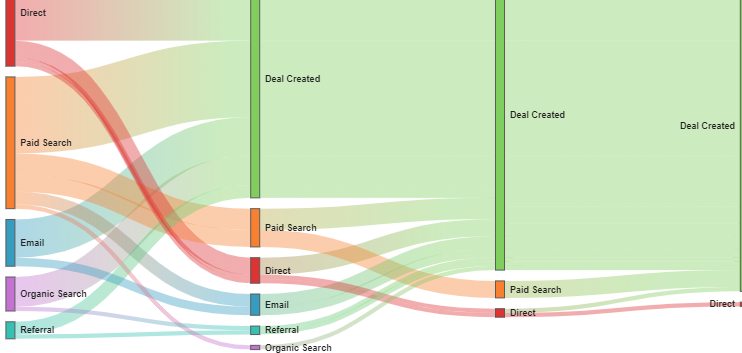What is Lead Attribution?
September 14, 2020 •DJ Team

As a marketer, you understand that it's important to enjoy a positive ROI on your efforts, but how do you know when you're succeeding? Where are people coming from? How are customers finding you? Which campaigns are making the most impact on your audience?
You can answer many of these questions when you analyze your leads. This is where lead attribution models come into play. So, let's dive into them a bit, shall we?
What is a Marketing Attribution Model?
Let's back up a little; lead attribution refers to the credit that's given for a customer's interaction with your brand at various phases within their buying journey. For example, if someone finds you via a Tweet you shouted out on Twitter, you'd want to know that, right? Same thing if you created a landing page that got tons of people to download your recent whitepaper. Campaign attribution gives credit to these various touchpoints by assigning a value to each interaction.
How Do You Make an Attribution Model?
There are several forms of digital marketing attribution models. If you're looking for an attribution model example, you need to first understand that your campaign influence has several touchpoints, and each lead attribution model assigns credit differently. Linear attribution, for example, gives equal weight and revenue to all touchpoints. Conversely, the time decay model gives more credit to customers' most recent interactions with your brand, versus those earlier on in the process, which may not have had as much impact.
There are many tools that offer marketing attribution software, such as Google's Attribution Modeling Tool (AMT). If you use the AMT, there are default attribution models built right into the software that will easily enable you to analyze your b2b marketing attribution, but there are holes in the AMT model. Oftentimes it is best to utilize multiple attribution models to get a comprehensive view of your marketing performance.
What is the Best Multi Channel Attribution Model?
In many cases, your customers come to you after hitting a number of touchpoints along their journeys. A marketing attribution CRM can help you capture the data that will ultimately inform your marketing team so they can tweak future campaigns in ways that are most likely to get attention from your audience. Using a CRM, you'll have access to a multi-touch attribution dashboard, which will allow you to track your customers' journeys and visualize the ROI that's applicable to each phase in your process.
A multi-touch attribution report is more complicated than what you'd see if you only had to examine one touchpoint. Let's talk a little more about the sales attribution models you might consider if you're dealing with a multi-touch system.
Linear Attribution Model
As mentioned previously, this model assigns equal credit to all touchpoints. With this being said, it doesn't show you which touchpoints were most influential and it may lead to data overload if you have a lot of touchpoints along the journey.
Time Decay Multi-Channel Model
The time decay model gives more revenue or conversion credits to interactions that happened closer to the time a visitor became a customer. The older (earlier) touchpoints receive less credit. This model is often useful if your sales cycle is long. In those cases, it doesn't always make sense to give credit to a bunch of touchpoints that are years old.
Position-Based Attribution Models
Position-based attribution models give more revenue credit to certain positions (or touchpoints within your buyers' journeys). These models might give more credit to First-Touch (the first interaction a customer has with your brand) and Lead Creation (the point at which the audience member became an engaged potential future customer) touchpoints. If you're using a position-based model, you might see your data presented in W-, U-, and Z-shaped graphs. The point is to enable you to see which touchpoints represent the greatest impact to your customers so you can focus on building your campaigns around those spaces.
What is Account-Based Attribution?
Equally as important as lead attribution tracking is account based attribution. The ABM (Account-Based Marketing) approach is a common topic in marketing meetings, but it is not as valuable if you can't accurately measure the impact - account-based attribution. When you close a deal, you are not reporting that you closed John Q from Acme Corp., you are reporting that you closed Acme Corp. This is where ABM attribution comes into play. ABM attribution groups leads into accounts and from there you can apply a multi-touch attribution approach to the entire account, not just one contact within the account.
How Do You Know Which Attribution Model to Use?
There is no one-size-fits-all answer. You need to determine your attribution strategy before you can choose the best digital marketing attribution model for your unique business. Remember, no single attribution model can cover everything; each one gives you a snapshot of the ROI you're bringing into your business, based on the strategy you select.
At Demand Jump, we're here to make insights actionable. Learn how our Analytics and Operations services can help you make the most of your marketing efforts. Need more help? Be sure to keep an eye on our blog, and if you have questions, don't be afraid to reach out. We love meeting new people!
Featured Articles
Categories
- Attribution Tracking (13)
- Channel Optimization (11)
- Consumer Insights (68)
- Content Marketing (251)
- Data Science (8)
- Digital Marketing (6)
- Digital Transformation (26)
- Enterprise (10)
- Lead Generation (14)
- Market Intelligence (8)
- Marketing Analytics (39)
- Marketing Attribution (57)
- Marketing Management (153)
- Marketing Operations (86)
- Organic Search (222)
- Paid Search (52)
- Pillar-Based Marketing (63)
- Programmatic Advertising (9)
- SaaS Content (14)
- SaaS Marketing (29)
- Search Marketing (111)
- SEO Keyword Research (28)
- SEO Pillar (18)
- SEO Strategy (46)
- SMB (5)
- Website Content (12)

